The AMD A8-7670K APU Review: Aiming for Rocket League
by Ian Cutress on November 18, 2015 8:00 AM ESTGaming Benchmarks: Low End
To satisfy our curiosity regarding low-power gaming, as well as dual graphics arrangements, we ran our regular suite through each processor. On this page are our integrated graphics results, along with a cheaper graphics solution in the R7 240 DDR3 and, in the case of AMD, both of these together in dual graphics mode.
Alien: Isolation
If first-person survival mixed with horror is your sort of thing, then Alien: Isolation, based off of the Alien franchise, should be an interesting title. Developed by Creative Assembly and released in October 2014, Alien: Isolation has won numerous awards, ranging from Game Of The Year to several top 10s/25s and Best Horror titles, ratcheting up over a million sales by February 2015. Alien: Isolation uses a custom-built engine that includes dynamic sound effects and should be fully multicore enabled.
For low-end graphics, we test at 720p with Ultra settings, whereas for mid- and high-range graphics, we bump this up to 1080p, taking the average frame rate as our marker with a scripted version of the built-in benchmark.

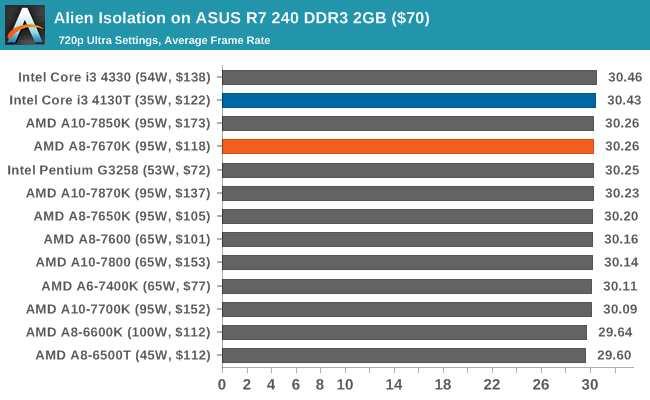
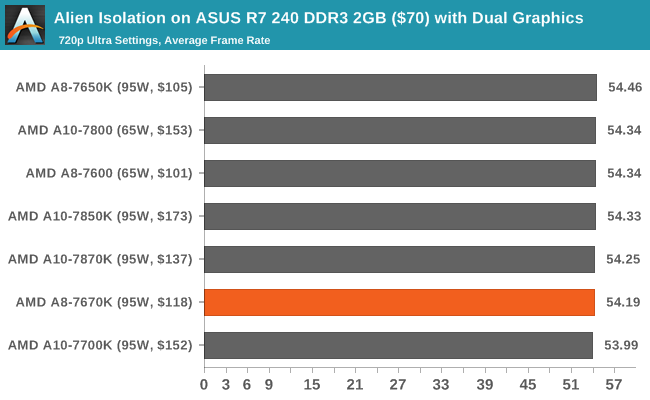
Total War: Attila
The Total War franchise moves on to Attila, another Creative Assembly development, and is a stand-alone strategy title set in 395AD where the main story line lets the gamer take control of the leader of the Huns in order to conquer parts of the world. Graphically, the game can render hundreds/thousands of units on-screen at once, all with their individual actions, and can put some of the big cards to task.
For low-end graphics, we test at 720p with performance settings, recording the average frame rate. With mid- and high-range graphics, we test at 1080p with the quality setting. In both circumstances, unlimited video memory is enabled, and the in-game scripted benchmark is used.
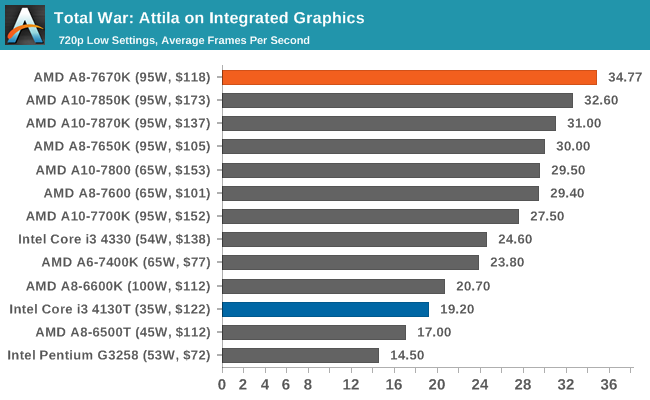

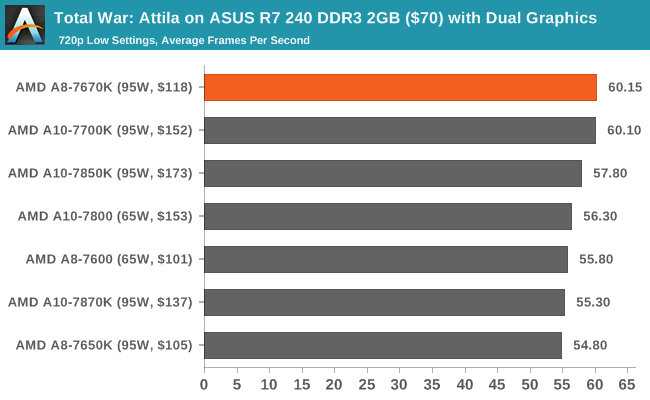
Grand Theft Auto V
The highly anticipated iteration of the Grand Theft Auto franchise finally hit the shelves on April 14, 2015, with both AMD and NVIDIA in tow to help optimize the title. GTA doesn’t provide graphical presets, but it opens up the options to users and extends the boundaries by pushing even the hardest systems to the limit using Rockstar’s Advanced Game Engine. Whether the user is flying high in the mountains with long draw distances or dealing with assorted trash in the city, when cranked up to maximum, it creates stunning visuals but hard work for both the CPU and the GPU.
For our test, we have scripted a version of the in-game benchmark, relying only on the final part, which combines a flight scene with an in-city drive-by, followed by a tanker explosion. For low-end systems, we test at 720p on the lowest settings, whereas mid- and high-end graphics play at 1080p with very high settings across the board. We record both the average frame rate and the percentage of frames under 60 fps (16.6 ms).

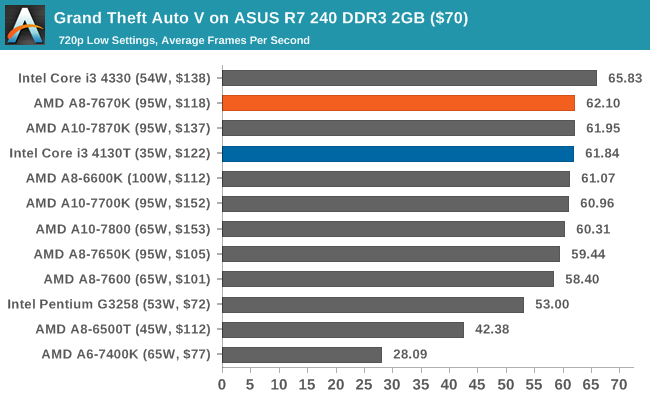
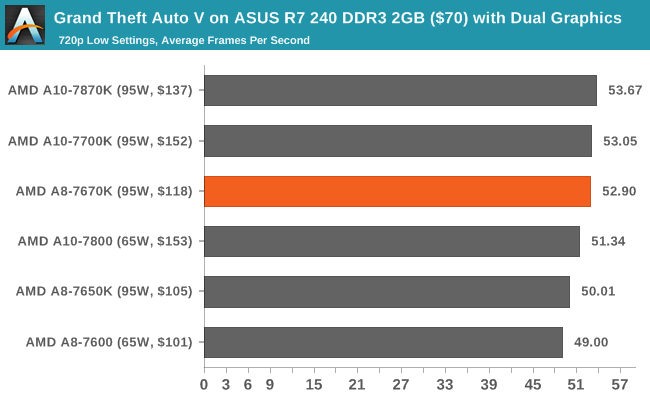
GRID: Autosport
No graphics test is complete without some input from Codemasters and the Ego engine, which means for this round of testing, we point toward GRID: Autosport, the next iteration in the GRID and racing genre. As with our previous racing testing, each update to the engine aims to add in effects, reflections, detail and realism, with Codemasters making "authenticity" a main focal point for this version.
GRID’s benchmark mode is very flexible, and as a result, we created a test race using a shortened version of the Red Bull Ring with 12 cars doing two laps. The player car is in focus throughout this benchmark and starts last, but usually finishes second or third. For low-end graphics, we test at 1080p and medium settings, whereas mid- and high-end graphics get the full 1080p maximum. Both the average and the minimum frame rates are recorded.
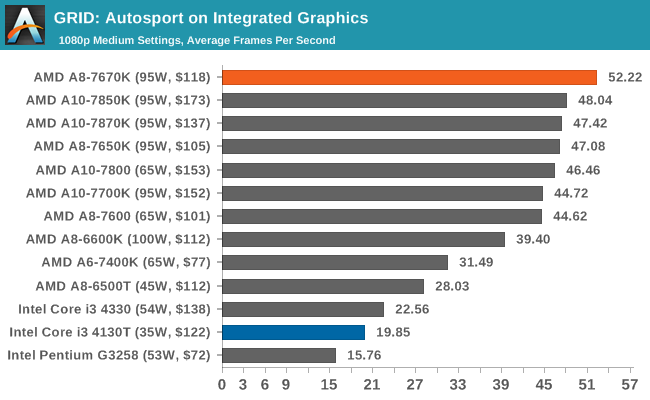
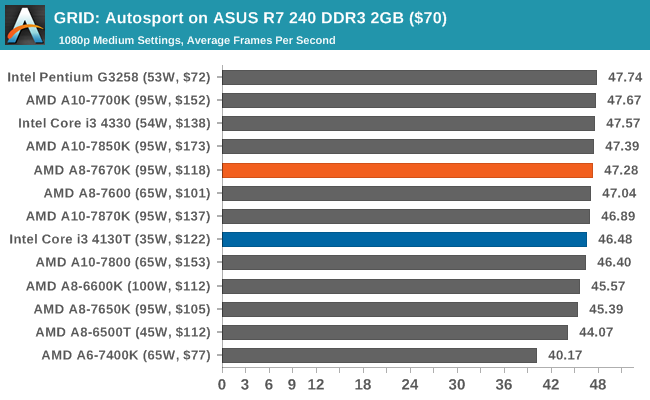
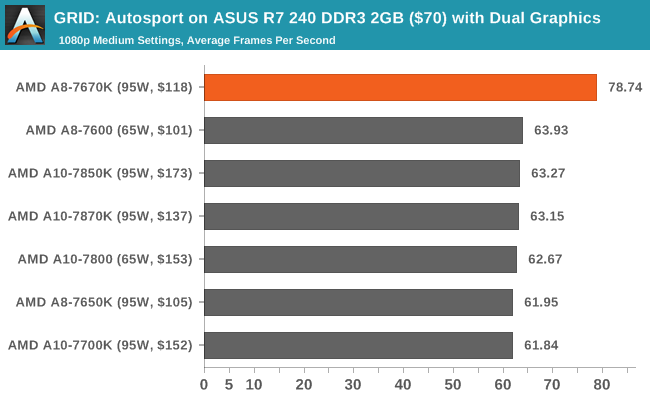
For whatever reason, the A8-7670K gets a good showing in the integrated tests, especially in dual graphics mode, with an abnormally high score. Some other issue might be at play here and warrants further testing.
Middle-Earth: Shadows of Mordor
The final title in our testing is another battle of system performance with the open-world action-adventure title Shadow of Mordor. Produced by Monolith using the LithTech Jupiter EX engine and numerous detail add-ons, SoM goes for detail and complexity to a large extent, despite having to be cut down from the original plans. The main story was written by the same writer as Red Dead Redemption, and it received Zero Punctuation’s Game of The Year in 2014.
For testing purposes, SoM gives a dynamic screen resolution setting, allowing us to render at high resolutions that are then scaled down to the monitor. As a result, we get several tests using the in-game benchmark. For low-end graphics, we examine at 720p with low settings, whereas mid- and high-end graphics get 1080p Ultra. The top graphics test is also redone at 3840x2160, also with Ultra settings, and we also test two cards at 4K where possible.
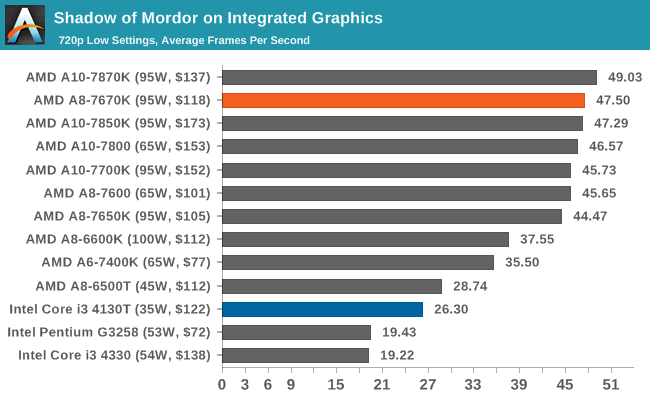
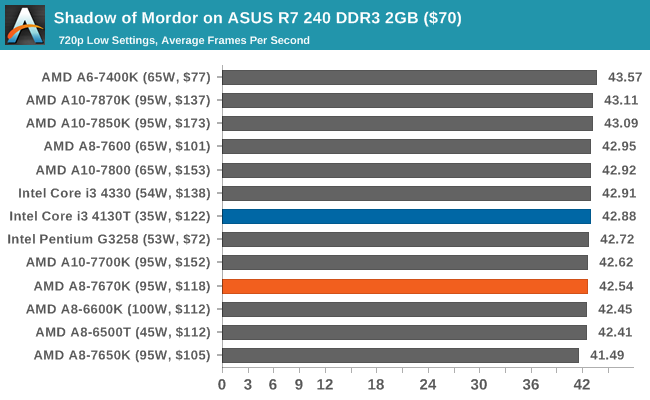
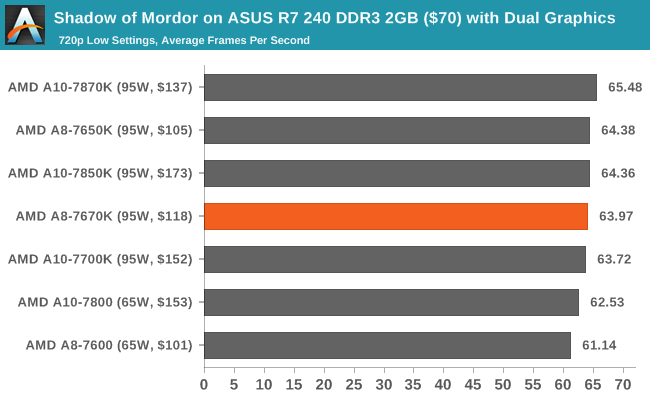















154 Comments
View All Comments
AS118 - Wednesday, November 18, 2015 - link
Well to be fair, the FX chips are strong enough and cheap (especially the $100 FX-6300) and you can pair them with a discrete GPU with ease. If you're trying to get a 1080p gaming rig for absolute cheapest price, a double AMD FX / GPU build works pretty well.That said, next year with Zen on 14nm will probably give people a good reason to get AMD. I just support AMD whenever I can because I dislike monopolies, and don't want Nvidia and Intel to become ones.
Sure they give good price for performance NOW, but that's because they have AMD to compete with them. If they didn't, I doubt the price would be "only a little higher" than AMD.
Oxford Guy - Wednesday, November 18, 2015 - link
8320E at $110 at Microcenter with UD3P 2.0 board is the best deal.JoeMonco - Wednesday, November 18, 2015 - link
"That said, next year with Zen on 14nm will probably give people a good reason to get AMD."Yeah, yeah. We hear this ever time a new AMD microarchitecture comes out and yet not a single one has lived up to the hype in more than a decade.
medi03 - Thursday, November 19, 2015 - link
Do you get paid to spread FUD about AMD or is it for free?JoeMonco - Thursday, November 19, 2015 - link
How can facts be "FUD"? If I'm wrong, please do tell which AMD CPU has been able to beat Intel in anything performance or TDP-wise since the Core2 from 2006. I won't hold my breath, though, since you'll just sling ad homs with no real facts.Deshi - Friday, November 20, 2015 - link
Yes, and that would be because only one new architecture (buldozer and its many variants) has been released in that past Decade, and we all know how that played out. Before that Athlon actually beat Intel for a good amount of time, and the same guy that worked on that is working on Zen. I'm somewhat hopeful that it won't be a bad design decision this time. I'm just hopeing its not too late. back in Athlon days, Intel was too pridefull and choose to ignore AMD initially, which is why AMD was able to take so much market share from them. I don't expect Intel to make the same mistake again this time.alistair.brogan - Wednesday, November 18, 2015 - link
This review doesn't compare with the new Pentium G4500. Skylake Pentium CPU cores with i5 Skylake integrated graphics. Faster and 1/3 the electricity/heat compared with the AMD APU. Only advantage amd has left is how some newer games don't run right without quad core, as they are bad ports from consoles....alistair.brogan - Wednesday, November 18, 2015 - link
50 dollars cheaper too, in Canadaalistair.brogan - Wednesday, November 18, 2015 - link
40-50 fps borderlands 2 on minimum settings (30-40 ultra settings) with HD 530 and the G4500Ian Cutress - Thursday, November 19, 2015 - link
As posted above, we don't have any of the other Skylake processors in yet. Benchmarking is always an iterative task - with limited space and resources you can't all benchmark them on the same day.But sure, if I could get all the processors in on day one, I would totally try test them all for comparion points.
Come back when/if we test the G4500 and see the numbers then.
And no, it's not a simple case of going out and buying this one SKU just for the niche comparison that you're interested in - there have been requests in the comment sections of reviews for other SKUs as well, and I've had a couple of emails for more SKUs on top of that.
Some SKUs are region limited (or slow roll out), or others are OEM only, so it can be hard to source outside the usual channels. So let me try and talk to Intel so we can get them all in, and then go from there. It's never an issue of lack of interest or subversion, just procurement (and ensuring we can communicate with the manufacturer at the point of testing).
Of course, the more readers that register their interest, the more I can pass it on up the chain to get them in.